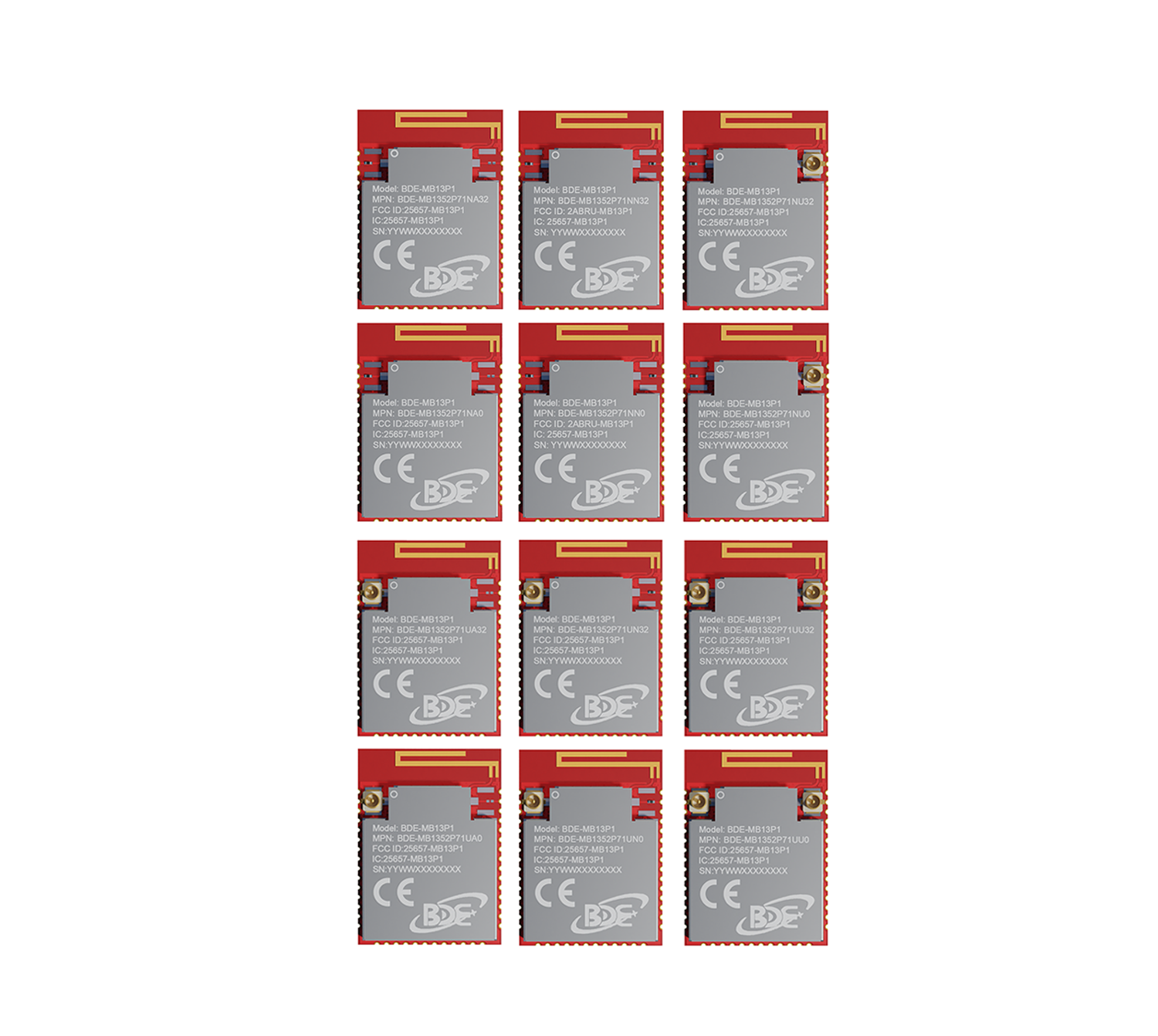- BDE-MB1352P71 (Muti-Band, Muti-Protocol with PA Based on CC1352P7)
- General Description
The BDE-MB1352P71 is a multi-band (Sub-1 GHz and 2.4 GHz), multi-protocol wireless module series with an integrated PA in the Sub-1 GHz band, based on Texas Instruments’ (TI) single-chip wireless microcontroller (MCU) CC1352P74T0RGZR. To meet different integration requirements, BDE offers multiple variants of this module series, as listed and described in Table 1.
The BDE-MB1352P71 integrates an Arm® Cortex®-M4F MCU and a dedicated software-controlled radio controller (Arm® Cortex®-M0). This architecture supports multiple physical layers and RF standards, including Thread, Zigbee®, Bluetooth® 5.2 Low Energy, IEEE 802.15.4g, IPv6-enabled smart objects (6LoWPAN), mioty, Wi-SUN, Amazon Sidewalk, proprietary systems, and TI 15.4-Stack for both Sub-1 GHz and 2.4 GHz bands. Concurrent multiprotocol operation is enabled through TI’s Dynamic Multiprotocol Manager (DMM) driver. The module features 704 KB flash, 144 KB SRAM, and 8 KB cache SRAM.
The module supports operation in the 861 – 1054 MHz and 2360 – 2500 MHz frequency bands, with up to +20 dBm TX power in the Sub-1 GHz band and +5 dBm TX power in the 2.4 GHz band.
The BDE-MB1352P71 has an ultra-low sleep current of 0.9 μA with RTC and 144 KB RAM retention, enabling long battery life for wireless applications. In addition to the main Cortex®-M4F processor, it includes an autonomous ultra-low-power Sensor Controller CPU with fast wake-up capability. For example, the sensor controller can perform 1 Hz ADC sampling at 1 μA system current. The device offers low SER (Soft Error Rate) FIT (Failure-In-Time) for long operational lifetime, and always-on RAM parity minimizes corruption risk from potential radiation events.
Optimized for low-power wireless communication and advanced sensing, the module is well-suited for grid infrastructure, building automation, retail automation, personal electronics, and medical applications.
The series integrates all required system-level components — including clocks, balun filter, passives, and a PCB trace antenna or U.FL connector — into a compact PCB form factor, ensuring easy assembly and low-cost PCB design.
Pre-certified with FCC, ISED, CE, and Bluetooth SIG, the BDE-MB1352P71 enables quick integration and fast time-to-market for customer products.
Table 1. Module Variants
Orderable Part Number
Antenna in Sub-1G
Antenna in 2.4G
On-board SPI Flash (Mbit)
Operating Temperature
BDE-MB1352P71UA32
U.FL Connector
PCB Trace Antenna
32
-40℃ to +85℃
BDE-MB1352P71NA32
ANT Pin
PCB Trace Antenna
BDE-MB1352P71UU32
U.FL Connector
U.FL Connector
BDE-MB1352P71NU32
ANT Pin
U.FL Connector
BDE-MB1352P71UN32
U.FL Connector
ANT Pin
BDE-MB1352P71NN32
ANT Pin
ANT Pin
BDE-MB1352P71UA0
U.FL Connector
PCB Trace Antenna
0
BDE-MB1352P71NA0
ANT Pin
PCB Trace Antenna
BDE-MB1352P71UU0
U.FL Connector
U.FL Connector
BDE-MB1352P71NU0
ANT Pin
U.FL Connector
BDE-MB1352P71UN0
U.FL Connector
ANT Pin
BDE-MB1352P71NN0
ANT Pin
ANT Pin
BDE-MB1352P71UA32-IN
U.FL Connector
PCB Trace Antenna
32
-40℃ to +105℃
BDE-MB1352P71NA32-IN
ANT Pin
PCB Trace Antenna
BDE-MB1352P71UU32-IN
U.FL Connector
U.FL Connector
BDE-MB1352P71NU32-IN
ANT Pin
U.FL Connector
BDE-MB1352P71UN32-IN
U.FL Connector
ANT Pin
BDE-MB1352P71NN32-IN
ANT Pin
ANT Pin
BDE-MB1352P71UA0-IN
U.FL Connector
PCB Trace Antenna
0
BDE-MB1352P71NA0-IN
ANT Pin
PCB Trace Antenna
BDE-MB1352P71UU0-IN
U.FL Connector
U.FL Connector
BDE-MB1352P71NU0-IN
ANT Pin
U.FL Connector
BDE-MB1352P71UN0-IN
U.FL Connector
ANT Pin
BDE-MB1352P71NN0-IN
ANT Pin
ANT Pin
Key Features
Wireless microcontroller Powerful 48-MHz Arm® Cortex®-M4F processor 704KB flash program memory 256KB of ROM for protocols and library functions 8KB of cache SRAM 144KB of ultra-low leakage SRAM with parity for high-reliability operation Dual-band Sub-1 GHz and 2.4 GHz operation Dynamic multiprotocol manager (DMM) driver Programmable radio includes support for 2-(G)FSK, 4-(G)FSK, MSK, OOK, Bluetooth®5.2 Low Energy, IEEE 802.15.4 PHY and MAC Supports over-the-air upgrade(OTA) Ultra-low power sensor controller Autonomous MCU with 4KB of SRAM Sample, store, and process sensor data Fast wake-up for low-power operation Software defined peripherals; capacitive touch, flow meter, LCD Low power consumption MCU consumption: 2.63 mA active mode, CoreMark 55 μA/MHz running CoreMark 0.8 μA standby mode, RTC, 144KB RAM 0.1 μA shutdown mode, wake-up on pin Ultra low-power sensor controller consumption: 25.2 μA in 2 MHz mode 701 μA in 24 MHz mode Radio Consumption: 5.4 mA RX at 868 MHz 6.4 mA RX at 2.4 GHz 9.8 mA TX at +5 dBm at 2.4 GHz 24.9 mA TX at +14 dBm at 868 MHz 64 mA TX at +20 dBm at 915 MHz Wireless protocol support Thread, Zigbee®, Matter Bluetooth® 5.2 Low Energy Wi-SUN Mioty Amazon Sidewalk Wireless M-Bus SimpleLink™ TI 15.4-stack 6LoWPAN Proprietary systems High performance radio -120 dBm for 2.5-kbps long-range mode -108 dBm at 50 kbps, 802.15.4, 868 MHz -102 Bm for Bluetooth® Low Energy 125-kbps Output power up to +20 dBm in Sub-1G with temperature compensation MCU peripherals Digital peripherals can be routed to any GPIO Four 32-bit or eight 16-bit general-purpose timers 12-bit ADC, 200 kSamples/s, 8 channels 8-bit DAC Two comparators Programmable current source Two UART, two SSI, I2C, I2S Real-time clock (RTC) Integrated temperature and battery monitor 24 GPIOs – none SPI flash versions 20 GPIOs – SPI flash versions Security enablers AES 128- and 256-bit cryptographic accelerator ECC and RSA public key hardware accelerator SHA2 Accelerator (full suite up to SHA-512) True random number generator (TRNG) Operating range On-chip buck DC/DC converter 1.8-V to 3.8-V single supply voltage 2.3-V to 3.6-V single supply voltage (SPI flash variants) -40 to +85°C or -40 to +105°C Antenna options
On-board SPI flash ANT pin for external antenna (Sub-1GHz & 2.4GHz) U.FL connector for external antenna (Sub-1GHz & 2.4GHz) Integrated PCB trace antenna (2.4GHz) 32-Mbit, only available in SPI flash versions Package LCC-42, 26 mm x 19 mm x 2.15 mm RoHS-compliant package Certification FCC ID: 2ABRU-MB13P1 IC: 25657-MB13P1 CE-RED Bluetooth SIG
Download
Datasheet: BDE-MB1352P71_Datasheet_V1.1.pdf
BDE-MB1352P71_Datasheet_V1.1.pdf
User Guide: - Pre: BDE-RFM208-IN (Industrial Multi-Band Based on CC1352R)
- Next: BDE-MB1354P101(Multi-Band with PA Based on CC1354P10)


